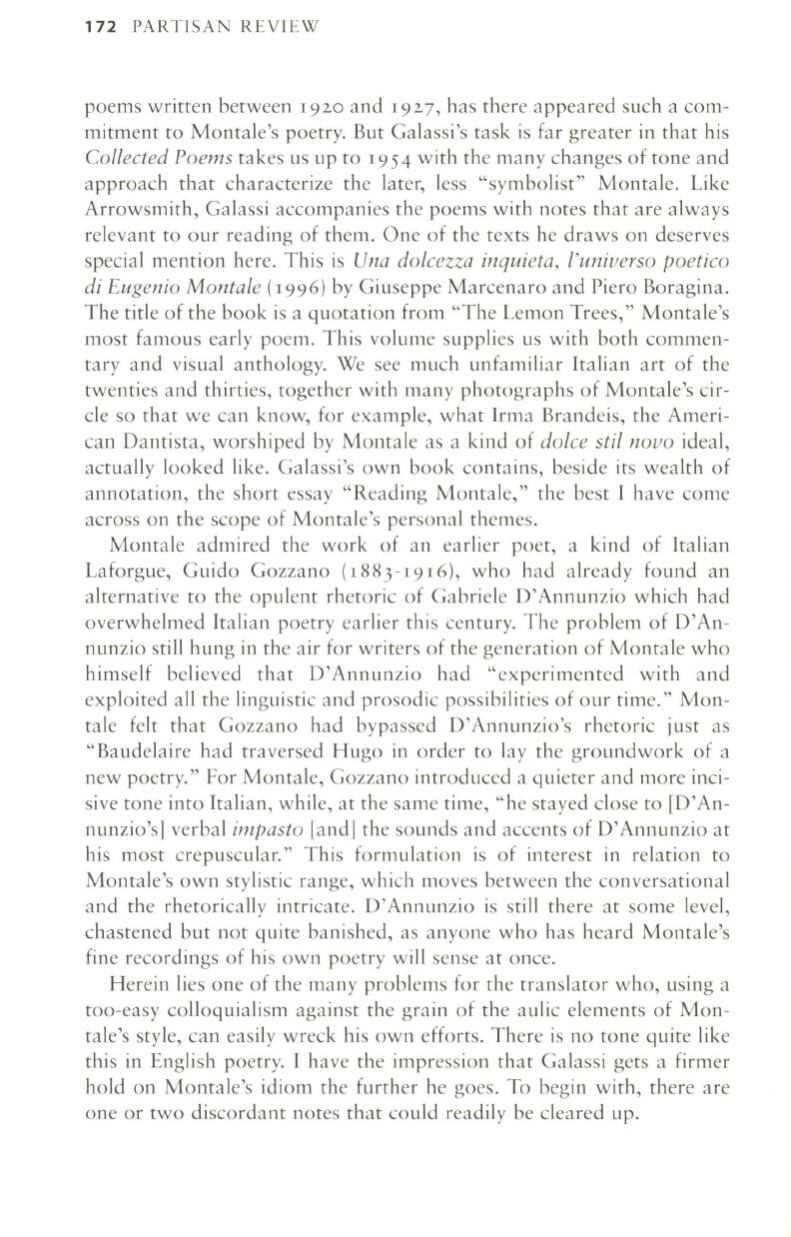
172
PARTISAN REVIEW
poems written between 1920 and 1927, has there appeared such a com–
mitment to Montale's poetry. But Galassi's task is far greater in that his
Collected Poems
takes us up to
1954
with the many changes of tone and
approach that characterize the later, less "symbolist" Montale. Like
Arrowsmith, Galassi accompanies the poems with notes that are always
relevant to our reading of them. One of the texts he draws on deserves
special mention here. This is
Una dolcezza inquieta, l'universo poetico
di Eugenio Montale
(1996) by Giuseppe Marcenaro and Piero Boragina.
The title of the book is a quotation from "The Lemon Trees," Montale's
most famous early poem. This volume supplies us with both commen–
tary and visual anthology. We see much unfamiliar Italian art of the
twenties and thirties, together with many photographs of Montale's cir–
cle so that we can know, for example, what Irma Brandeis, the Ameri–
can Dantista, worshiped by Montale as a kind of
dolce stil novo
ideal,
actually looked like. Galassi's own book contains, beside its wealth of
annotation, the short essay "Reading Montale," the best [ have come
across on the scope of Montale's personal themes.
Montale admired the work of an earlier poet, a kind of Italian
Laforgue, Guido Gozzano (1883-1916), who had already found an
alternative to the opulent rhetoric of Gabriele D'Annunzio which had
overwhelmed Italian poetry earlier this century. The problem of D'An–
nunzio still hung in the air for writers of the generation of Montale who
himself believed that D'Annunzio had "experimented with and
exploited all the linguistic and prosodic possibilities of our time." Mon–
tale felt that Gozzano had bypassed D'Annunzio's rhetoric just as
"Baudelaire had traversed Hugo in order to lay the groundwork of a
new poetry." For Montale, Gozzano introduced a quieter and more inci–
sive tone into Italian, while, at the same time, "he stayed close to [D'An–
nunzio'sJ verbal
impasto
land J the sounds and accents of D' Annunzio at
his most crepuscular." This formulation is of interest in relation to
Montale's own stylistic range, which moves between the conversational
and the rhetorically intricate. D'Annunzio is still there at some level,
chastened but not quite banished, as anyone who has heard Montale's
fine recordings of his own poetry will sense at once.
Herein lies one of the many problems for the translator who, using a
too-easy colloquialism against the grain of the aulie elements of Mon–
tale's style, can easily wreck his own efforts. There is no tone quite like
this in English poetry. I have the impression that Galassi gets a firmer
hold on Montale's idiom the further he goes. To begin with, there are
one or two discordant notes that could readily be cleared up.


